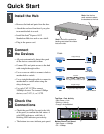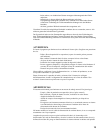
6
Connection Guidelines
General
• The 140T is capable of autonegotiating port speed and can operate at
10Mbps or 100Mbps per port. The hub matches the highest possible
speed of an attached device.
• The ports on the 140T hub are half-duplex. The hub cannot connect
to a device at full-duplex.
• To prevent a loop in the network, do not connect the 140T to 10Mbps
and 100Mbps segments simultaneously if the 10Mbps and 100Mbps
segments are bridged externally (through a switch).
Cabling
• Use Category 5 unshielded twisted-pair (CAT 5 UTP) cable when
connecting 100Mbps devices to the hub.
• Use Category 3, 4, or 5 unshielded twisted-pair (CAT 3, 4, 5 UTP)
cable when connecting 10Mbps devices to the hub.
• Limit the cable length between devices to 100 meters.
• Use crossover cables or the daisy-chain port to connect to a hub
or switch.
• Use a straight-through cable to connect the hub to a server or
workstation. For more information on cabling, see pages 8-9.
Bridging Segments
A bridge allows two segments to communicate with each other. Typically, a
bridge connects segments operating at different speeds. The 140T contains
an internal bridge that automatically allows devices operating at 10Mbps to
communicate with devices operating at 100Mbps.
i
R
100Mbps
Daisy-chain
MDI
1510304050+1510304050+
Traffic %
10Mbps
Power
10Mbps 100Mbps
Collisions
or
Port
Activity
Port
Speed
Intel
®
Express 140T
Standalone Hub
Solid green = Link
Blinking green = Activity
Orange = Autodisabled
Solid Green = 100Mbps
Off = 10Mbps
Class
II
910
11
12
5678
13 14 15 16
12
3
4
9101112
9101112
12345678
13 1415 16
12345678
13 1415 16
10
Connecting to Devices
10Mbps Hub
Server
Shared
Printer
10Mbps
Clients
10 and
100Mbps
Clients
10Mbps
100Mbps


















